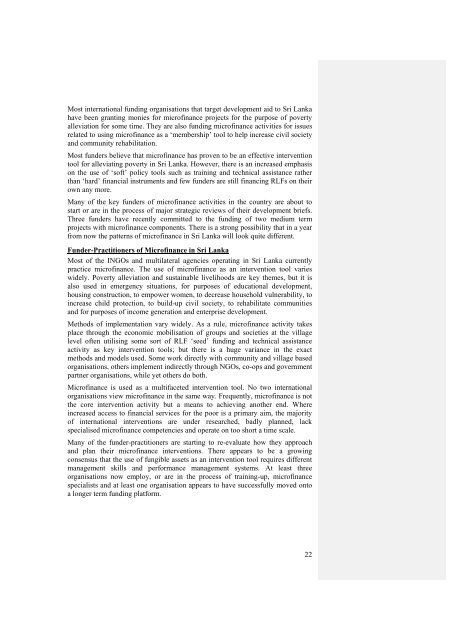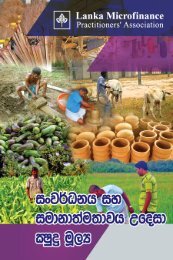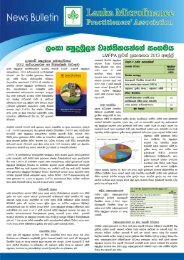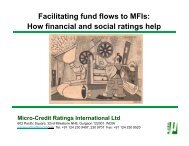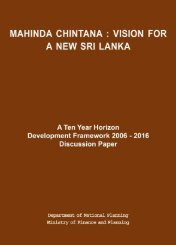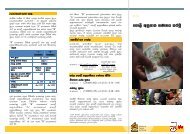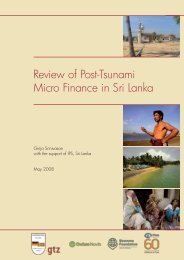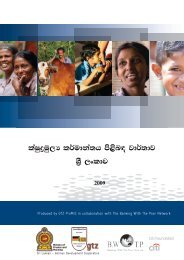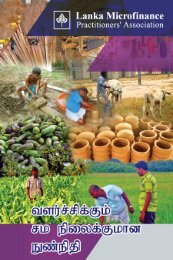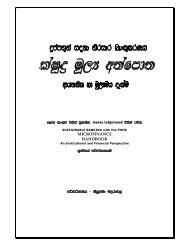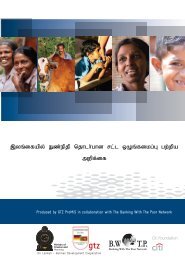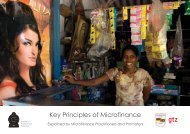National Microfinance Study of Sri Lanka: Survey of Practices and ...
National Microfinance Study of Sri Lanka: Survey of Practices and ...
National Microfinance Study of Sri Lanka: Survey of Practices and ...
You also want an ePaper? Increase the reach of your titles
YUMPU automatically turns print PDFs into web optimized ePapers that Google loves.
Most international funding organisations that target development aid to <strong>Sri</strong> <strong>Lanka</strong><br />
have been granting monies for micr<strong>of</strong>inance projects for the purpose <strong>of</strong> poverty<br />
alleviation for some time. They are also funding micr<strong>of</strong>inance activities for issues<br />
related to using micr<strong>of</strong>inance as a ‘membership’ tool to help increase civil society<br />
<strong>and</strong> community rehabilitation.<br />
Most funders believe that micr<strong>of</strong>inance has proven to be an effective intervention<br />
tool for alleviating poverty in <strong>Sri</strong> <strong>Lanka</strong>. However, there is an increased emphasis<br />
on the use <strong>of</strong> ‘s<strong>of</strong>t’ policy tools such as training <strong>and</strong> technical assistance rather<br />
than ‘hard’ financial instruments <strong>and</strong> few funders are still financing RLFs on their<br />
own any more.<br />
Many <strong>of</strong> the key funders <strong>of</strong> micr<strong>of</strong>inance activities in the country are about to<br />
start or are in the process <strong>of</strong> major strategic reviews <strong>of</strong> their development briefs.<br />
Three funders have recently committed to the funding <strong>of</strong> two medium term<br />
projects with micr<strong>of</strong>inance components. There is a strong possibility that in a year<br />
from now the patterns <strong>of</strong> micr<strong>of</strong>inance in <strong>Sri</strong> <strong>Lanka</strong> will look quite different.<br />
Funder-Practitioners <strong>of</strong> <strong>Micr<strong>of</strong>inance</strong> in <strong>Sri</strong> <strong>Lanka</strong><br />
Most <strong>of</strong> the INGOs <strong>and</strong> multilateral agencies operating in <strong>Sri</strong> <strong>Lanka</strong> currently<br />
practice micr<strong>of</strong>inance. The use <strong>of</strong> micr<strong>of</strong>inance as an intervention tool varies<br />
widely. Poverty alleviation <strong>and</strong> sustainable livelihoods are key themes, but it is<br />
also used in emergency situations, for purposes <strong>of</strong> educational development,<br />
housing construction, to empower women, to decrease household vulnerability, to<br />
increase child protection, to build-up civil society, to rehabilitate communities<br />
<strong>and</strong> for purposes <strong>of</strong> income generation <strong>and</strong> enterprise development.<br />
Methods <strong>of</strong> implementation vary widely. As a rule, micr<strong>of</strong>inance activity takes<br />
place through the economic mobilisation <strong>of</strong> groups <strong>and</strong> societies at the village<br />
level <strong>of</strong>ten utilising some sort <strong>of</strong> RLF ‘seed’ funding <strong>and</strong> technical assistance<br />
activity as key intervention tools; but there is a huge variance in the exact<br />
methods <strong>and</strong> models used. Some work directly with community <strong>and</strong> village based<br />
organisations, others implement indirectly through NGOs, co-ops <strong>and</strong> government<br />
partner organisations, while yet others do both.<br />
<strong>Micr<strong>of</strong>inance</strong> is used as a multifaceted intervention tool. No two international<br />
organisations view micr<strong>of</strong>inance in the same way. Frequently, micr<strong>of</strong>inance is not<br />
the core intervention activity but a means to achieving another end. Where<br />
increased access to financial services for the poor is a primary aim, the majority<br />
<strong>of</strong> international interventions are under researched, badly planned, lack<br />
specialised micr<strong>of</strong>inance competencies <strong>and</strong> operate on too short a time scale.<br />
Many <strong>of</strong> the funder-practitioners are starting to re-evaluate how they approach<br />
<strong>and</strong> plan their micr<strong>of</strong>inance interventions. There appears to be a growing<br />
consensus that the use <strong>of</strong> fungible assets as an intervention tool requires different<br />
management skills <strong>and</strong> performance management systems. At least three<br />
organisations now employ, or are in the process <strong>of</strong> training-up, micr<strong>of</strong>inance<br />
specialists <strong>and</strong> at least one organisation appears to have successfully moved onto<br />
a longer term funding platform.<br />
22


